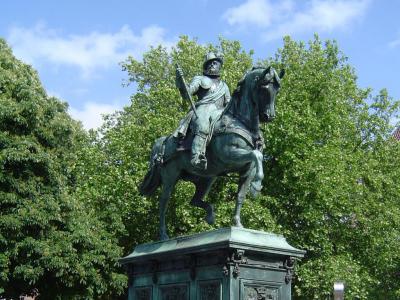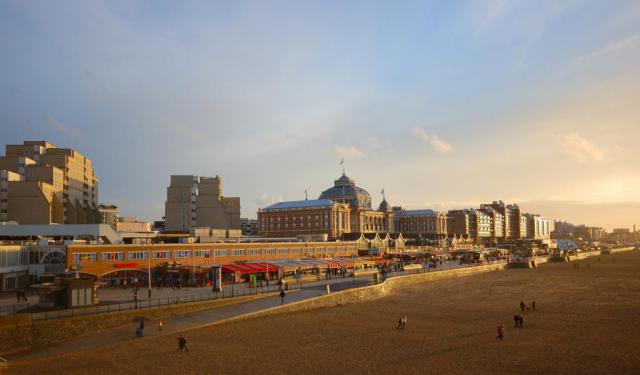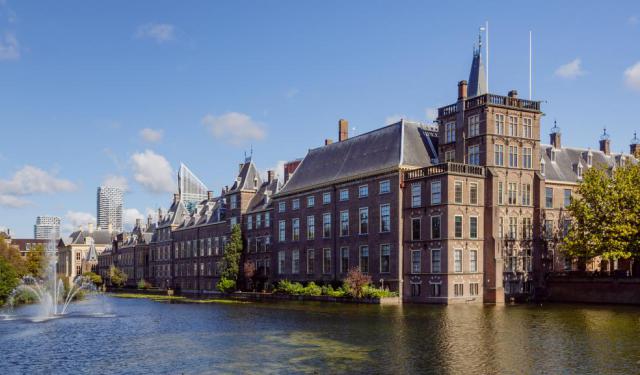Ruiterstandbeeld Willem I (Equestrian statue of William I), Hague
The Equestrian statue of William I, located in The Hague, is a monument of historical significance that has sparked some controversy due to its interesting history. In 1843, Emile de Nieuwerkercke, a French sculptor, presented King William II with a model for an equestrian statue of Prince William of Orange. King William II was immediately impressed by the design and personally financed the project. The statue was unveiled in 1845 and was placed opposite the Noordeinde Palace.
Interestingly, this project coincided with another effort led by a national commission and sculptor Royer, who had received approval in 1842 to work on a statue of the prince. However, Royer's statue was completed in 1848, three years after Nieuwerkercke's. The reasons for the delay in Royer's work remain unclear, but the king's decision to commission and erect the Nieuwerkercke statue before Royer's created significant controversy.
The Equestrian statue of William I is notable for being the oldest free-standing statue in The Hague and the first equestrian statue in the Netherlands. Nieuwerkercke portrayed Prince William of Orange as a commanding figure, embodying the image of an absolute ruler – a general in armor, holding a marshal's staff, and mounted on a horse. This representation, inspired by classical antiquity, symbolizes absolute power and likely resonated with King William II, who was renowned for his role in the defeat of Napoleon at Waterloo in 1815.
Interestingly, this project coincided with another effort led by a national commission and sculptor Royer, who had received approval in 1842 to work on a statue of the prince. However, Royer's statue was completed in 1848, three years after Nieuwerkercke's. The reasons for the delay in Royer's work remain unclear, but the king's decision to commission and erect the Nieuwerkercke statue before Royer's created significant controversy.
The Equestrian statue of William I is notable for being the oldest free-standing statue in The Hague and the first equestrian statue in the Netherlands. Nieuwerkercke portrayed Prince William of Orange as a commanding figure, embodying the image of an absolute ruler – a general in armor, holding a marshal's staff, and mounted on a horse. This representation, inspired by classical antiquity, symbolizes absolute power and likely resonated with King William II, who was renowned for his role in the defeat of Napoleon at Waterloo in 1815.
Want to visit this sight? Check out these Self-Guided Walking Tours in Hague. Alternatively, you can download the mobile app "GPSmyCity: Walks in 1K+ Cities" from Apple App Store or Google Play Store. The app turns your mobile device to a personal tour guide and it works offline, so no data plan is needed when traveling abroad.
Ruiterstandbeeld Willem I (Equestrian statue of William I) on Map
Sight Name: Ruiterstandbeeld Willem I (Equestrian statue of William I)
Sight Location: Hague, Netherlands (See walking tours in Hague)
Sight Type: Attraction/Landmark
Sight Location: Hague, Netherlands (See walking tours in Hague)
Sight Type: Attraction/Landmark
Walking Tours in Hague, Netherlands
Create Your Own Walk in Hague
Creating your own self-guided walk in Hague is easy and fun. Choose the city attractions that you want to see and a walk route map will be created just for you. You can even set your hotel as the start point of the walk.
Scheveningen Walking Tour
Originally an independent fishing village, today Scheveningen is one of The Hague's eight districts. With its long beaches loved by both the young and old in all seasons, Scheveningen gets particularly crowded in summer.
Modern as it is, this seaside resort, the most popular in Holland, boasts a great deal of history – stretching all the way back to 1280 – with the locals still... view more
Tour Duration: 1 Hour(s)
Travel Distance: 2.7 Km or 1.7 Miles
Modern as it is, this seaside resort, the most popular in Holland, boasts a great deal of history – stretching all the way back to 1280 – with the locals still... view more
Tour Duration: 1 Hour(s)
Travel Distance: 2.7 Km or 1.7 Miles
Hague's Classic Architectural Jewels
As the third largest metropolis in the Netherlands, The Hague has plenty to offer architecturally discerning travelers. The city is a living proof of a harmonious coexistence between a modern, easy on the eye skyline and a steeped in history downtown. Owing to its fascinating (political) past, The Hague has a plethora of historic buildings associated with worship, governance, royalty and... view more
Tour Duration: 2 Hour(s)
Travel Distance: 2.9 Km or 1.8 Miles
Tour Duration: 2 Hour(s)
Travel Distance: 2.9 Km or 1.8 Miles
The Hague Introduction Walking Tour
While the official capital of the Netherlands is Amsterdam, The Hague is the country's de facto capital and administrative center.
Little is known about the origin of The Hague as such. What is certain is that it was founded by one of the last counts of the House of Holland, Floris IV, who already owned two residences in the area, but had his eye set on a waterfront property near the pond... view more
Tour Duration: 2 Hour(s)
Travel Distance: 3.5 Km or 2.2 Miles
Little is known about the origin of The Hague as such. What is certain is that it was founded by one of the last counts of the House of Holland, Floris IV, who already owned two residences in the area, but had his eye set on a waterfront property near the pond... view more
Tour Duration: 2 Hour(s)
Travel Distance: 3.5 Km or 2.2 Miles






